Why Quick Action Matters When Your Toilet Won't Flush
Clogged toilet repair doesn't have to ruin your day or your bathroom floor. Nobody likes a clogged toilet, but chances are you'll have to deal with one eventually—if you haven't already. The good news? Most toilet clogs can be fixed quickly with the right approach and basic tools.
Quick Fix Guide for Clogged Toilet Repair:
- Stop flushing immediately - prevents overflow
- Use a flange plunger - creates better seal than cup plungers
- Try hot water and dish soap - if no plunger available
- Use a toilet auger - for stubborn clogs
- Call a professional - if multiple fixtures are affected
As one expert puts it: "This isn't the easiest thing to do, but it is the most effective." The key is staying calm and taking the right steps in order.
Most toilet clogs happen for predictable reasons. Too much toilet paper, flushing items that shouldn't go down (like wipes or feminine products), or foreign objects are the usual culprits. Even curious kids "teaching big bird to swim" can create a plumbing emergency.
The most important thing? Don't panic and don't keep flushing. That's how you turn a simple clog into a messy overflow situation. Instead, turn off the water supply valve behind the toilet and assess the situation.
In this guide, we'll walk you through everything from basic plunging techniques to when it's time to call in the pros. Most clogs can be handled with simple DIY methods, but knowing your limits can save you from bigger problems down the line.

First Steps & Common Causes: What to Do and Why It Happened
When your toilet suddenly refuses to cooperate, your heart might skip a beat. Take a deep breath—you've got this! The first few moments are crucial for preventing a small hiccup from becoming a bathroom disaster.
The golden rule of clogged toilet repair? Stop flushing immediately. We know it's tempting to try "one more flush," but this is the fastest way to turn a simple clog into a soggy mess on your bathroom floor.
Your first mission is to prevent overflow. If you see water rising in the bowl, don't panic. Remove the toilet tank lid and look inside—you'll see a rubber flapper at the bottom. Push it down firmly to seal the opening. This stops more water from entering the bowl while you work on the problem.
Next, locate the water supply valve behind your toilet (it's usually a small knob on the wall or floor) and turn it clockwise to shut off the water supply. If the valve is stuck or you can't reach it quickly, lift the float ball inside the tank instead. This immediately stops the filling process and gives you breathing room.
Now it's time to assess the situation and protect your floor. Grab some old towels or newspapers and spread them around the toilet base. Trust us—even the most careful clogged toilet repair can get a little splashy. And please, wear rubber gloves! Your hands will thank you later.
Why Toilets Clog
Here's the truth: toilets are pretty simple creatures. They're designed to handle human waste and toilet paper—that's it. When we ask them to do more, they rebel in the form of clogs.
The biggest troublemaker? Non-flushable items that masquerade as toilet-friendly. Those "flushable" wipes aren't as flushable as they claim. Paper towels, feminine products, cotton swabs, dental floss, and hair all spell trouble for your plumbing. These items don't break down like toilet paper and create stubborn blockages in your pipes.
Foreign objects are another common culprit, especially in homes with kids. We've seen everything from toy cars to jewelry take an unexpected swim. If something falls in, try to fish it out before flushing—once it's in the toilet trap, removal becomes much trickier.
Too much toilet paper can overwhelm even the most cooperative toilet, particularly if you have a low-flow toilet from the mid-1990s. These water-saving models sometimes lack the flushing power to move large wads of paper effectively.
Sometimes the problem lies deeper. Fats, oils, and grease that get flushed can solidify in your pipes, contributing to main drain issues. Tree roots can invade sewer lines, and old pipes may have deteriorated over time. If multiple fixtures in your home are draining slowly, you're likely dealing with a main drain issue rather than a simple toilet clog.
The blocked toilet trap—that S-shaped bend beneath your toilet bowl—is where many clogs make their final stand. It's designed to hold water and prevent sewer gases from entering your home, but it's also a perfect spot for debris to get stuck.
Immediate Actions to Prevent a Mess
Acting quickly can save your bathroom from a watery disaster. The moment you notice water rising in the bowl, resist the urge to flush again. Instead, focus on stopping the overflow by reaching for that water supply shut-off valve behind your toilet.
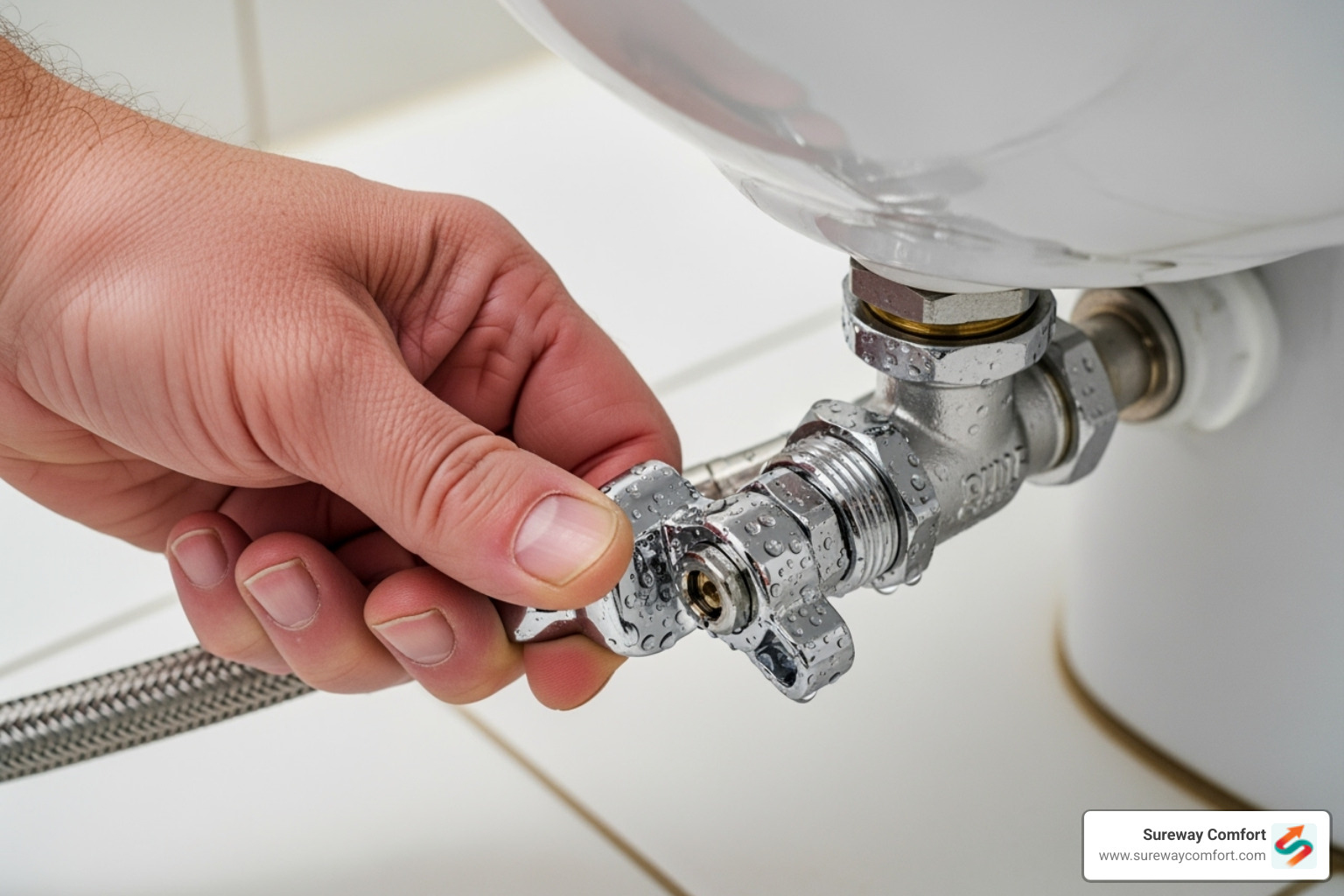
Turn the valve clockwise—it might be stiff if it hasn't been used in a while, so don't be afraid to use a little muscle. If the valve won't budge or you can't reach it quickly, lift the float ball inside the tank. This triggers the fill valve to stop, buying you precious time to address the clog.
Prepare the area by laying down towels or newspapers around the toilet base. Even experienced DIYers can create splashes during clogged toilet repair, so protect your floors now. A little preparation goes a long way toward keeping your bathroom dry and your stress levels manageable.
Don't forget those rubber gloves—this isn't just about comfort, it's about hygiene. Toilet water contains bacteria you definitely don't want on your hands, especially when you're working up close with plunging and other repair methods.
With these immediate steps complete, you're ready to tackle the actual clog. Most toilet clogs are completely manageable with the right approach and a little patience.
Your DIY Toolkit: A Guide to Clogged Toilet Repair
Now that you've stopped the immediate crisis and understand what might have caused your toilet troubles, it's time to get down to business. The good news? Most clogged toilet repair jobs are totally manageable with some basic tools and a bit of patience. We've helped countless homeowners in the Mt. Lebanon area tackle these issues, and we're confident you can handle this too.
Before we dive into the actual repair methods, let's talk safety. Make sure your bathroom has good ventilation – crack a window if you can. Keep those rubber gloves on throughout the process, and take your time. Rushing through plumbing repairs often leads to bigger problems down the road.
Using a Plunger for Minor Clogged Toilet Repair
Your trusty plunger is like the Swiss Army knife of clogged toilet repair – simple, reliable, and surprisingly effective when you know how to use it properly. But here's something many people don't realize: not all plungers work the same for toilets.
You'll want to grab a flange plunger rather than the standard cup plunger you might use on your kitchen sink. The flange plunger has that extra rubber flap (the flange) that extends from the bottom, and it's specifically designed to create a perfect seal in your toilet's drain opening. Trust us, this makes all the difference in the world.
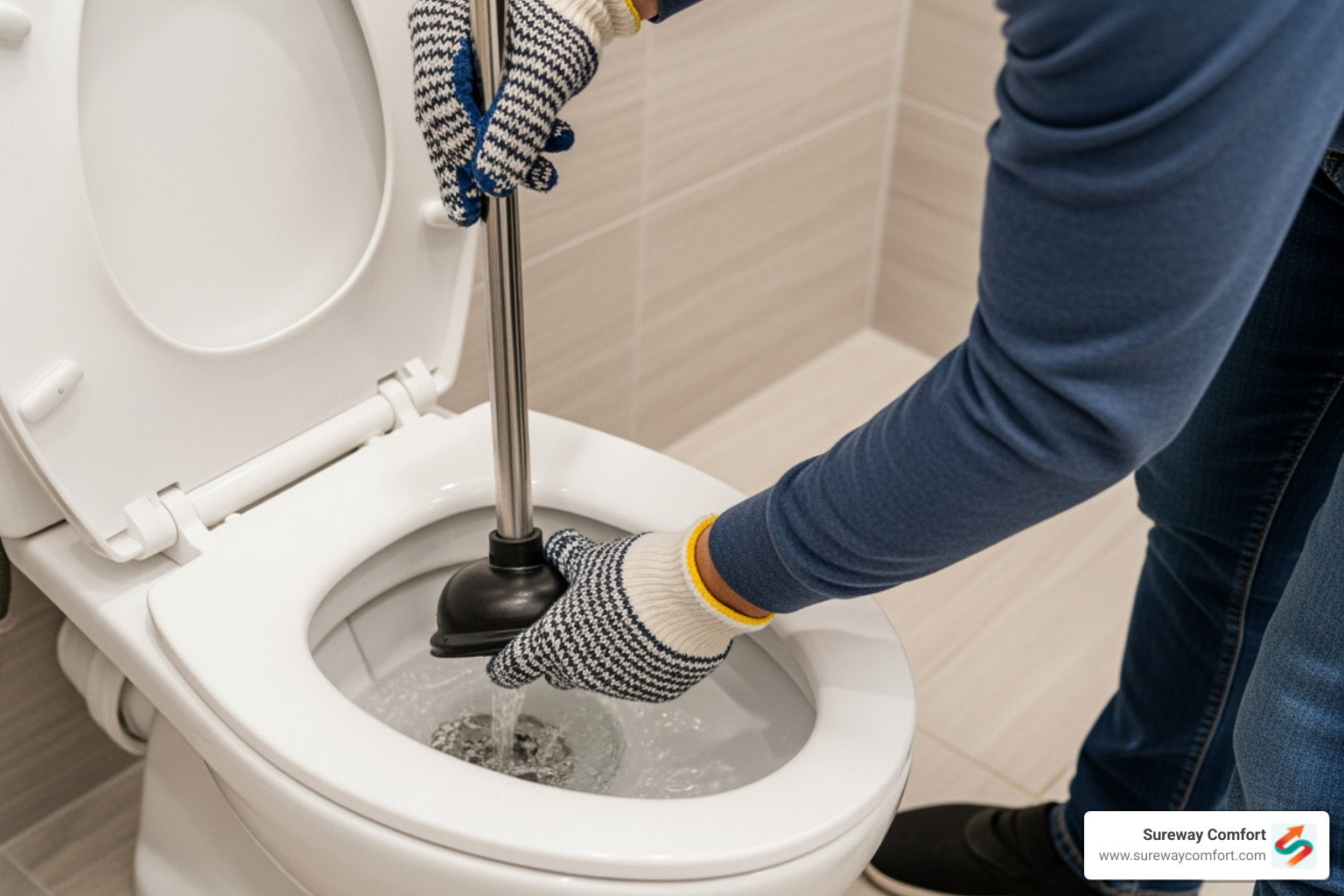
Here's how to make your plunger work like a pro. First, position the plunger so that flange sits snugly over the toilet's drain hole – you want that airtight seal. If there's not enough water in the bowl to cover the plunger head, add some warm (not hot!) water from a bucket. The plunger needs to be submerged to work effectively.
Start with a gentle initial push to expel any air trapped under the plunger cup. This helps create that crucial vacuum seal we're after. Once you've got a good seal, it's time for some vigorous action. Push down firmly, then pull up sharply, breaking the seal on the upstroke. The magic happens in this push-and-pull motion – you're creating alternating pressure and suction that works to break apart whatever's causing the blockage.
Keep this rhythm going for about 15-20 plunges, then pull the plunger completely away from the drain. If you hear that satisfying "whoosh" of water draining, congratulations! Give your toilet a couple of test flushes to make sure everything's flowing smoothly and the clog is completely gone.
If the water level stays stubbornly high, don't get discouraged. Sometimes it takes a few rounds of plunging to fully break up a clog. Patience really is your friend here – we've seen homeowners give up too early when they were just a few plunges away from success.
The humble plunger has been solving toilet troubles for over a century, and there's fascinating history behind this simple tool. You can learn more about how plungers work and their evolution on Wikipedia.
Advanced Clogged Toilet Repair: Using a Toilet Auger (Snake)
When your plunger has given its best effort but your toilet remains stubbornly clogged, it's time to call in the heavy artillery. Meet the toilet auger, also known as a closet auger or plumbing snake. This specialized tool is designed specifically for toilets and can reach clogs that are deeper in your toilet's trap.
What makes a toilet auger different from other drain snakes is its protective rubber sleeve that prevents scratching your toilet's porcelain surface. Regular drain snakes can cause expensive damage to your toilet bowl, so don't try to substitute one for the other.
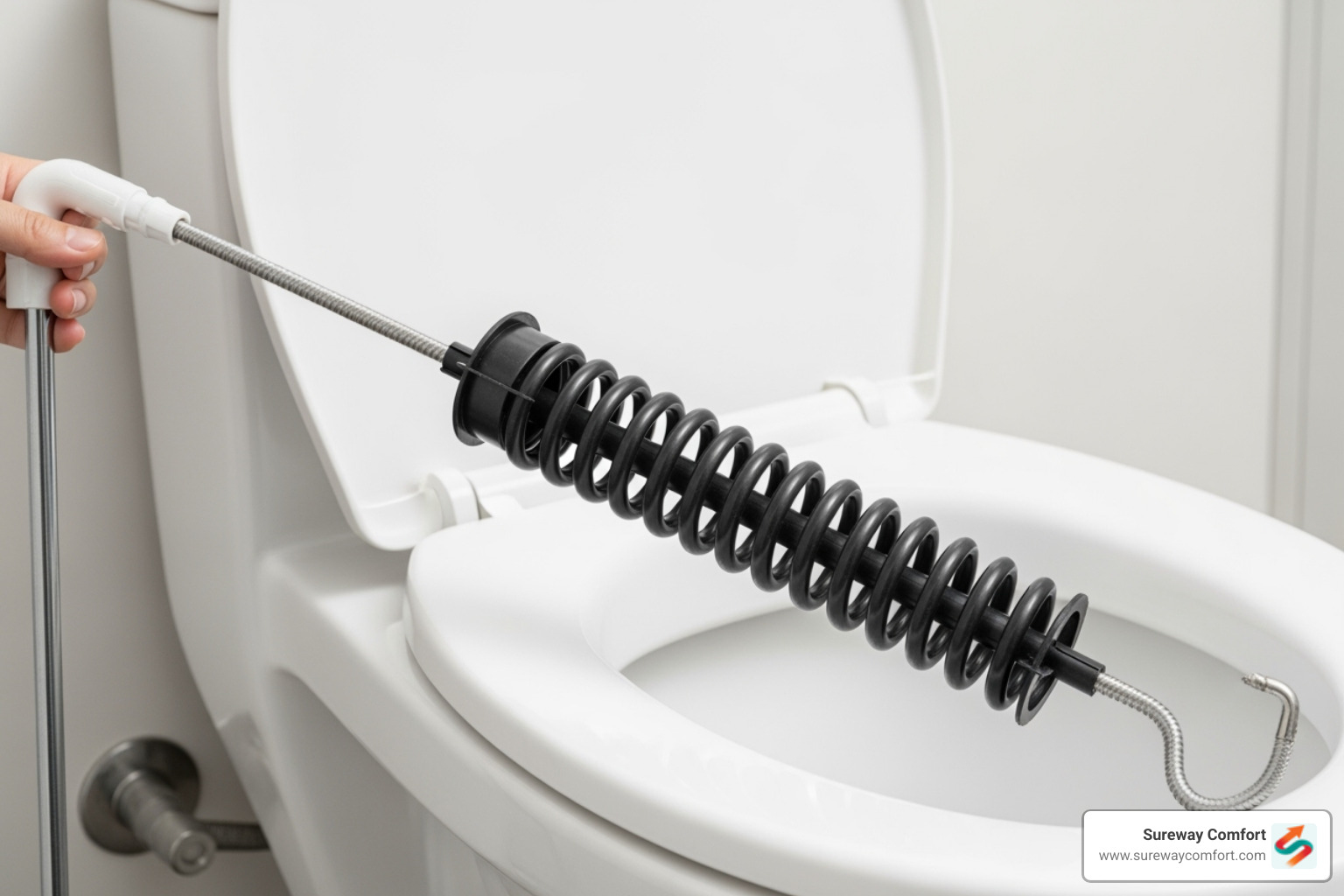
Using a toilet auger takes a bit more finesse than plunging, but it's still within reach of most DIYers. Start by extending the auger's cable by pulling up on the handle – you'll see the coiled metal end that does the actual work. Insert the cable carefully into the toilet's drain opening, making sure that protective sleeve stays against the porcelain.
Feed the cable down into the trap until you feel resistance – that's likely your clog saying hello. Now comes the important part: crank the handle clockwise while simultaneously pushing the cable forward. This corkscrewing action helps the auger's tip either bore through the blockage or hook onto it so you can pull it out.
You'll know you've made contact when you feel the auger catch or snag something. When this happens, carefully pull the auger back out, retracting the cable as you go. You might be surprised what comes up – we've seen everything from massive wads of toilet paper to mysterious foreign objects that somehow found their way into the toilet.
Once you've retrieved the clog, flush the toilet several times to make sure everything's flowing properly. Then give your auger a thorough cleaning before storing it away. Pro tip: if you're in the market for a toilet auger, go with a 6-foot model over a 3-foot one – that extra reach can make all the difference for stubborn, deep clogs.
No Plunger? No Problem! DIY Hacks and What to Avoid
Life has a way of throwing curveballs when you least expect them. Maybe you're dealing with a clog at 2 AM and don't have a plunger handy, or perhaps you're visiting someone else's home and need to solve the problem discreetly. We've got some alternative methods that can work in a pinch, along with some crucial warnings about what NOT to try.
The hot water and dish soap method is our favorite emergency technique. Pour about a quarter cup of liquid dish soap into the toilet bowl – the soap is denser than water and designed to break down grease and organic matter. Follow this with a gallon of hot (but not boiling!) water poured from about waist height. The combination of heat and soap can work wonders on clogs caused by excessive toilet paper or organic waste. Let this mixture sit for 10-15 minutes, or even longer if you can wait, then try flushing.
Baking soda and vinegar is the classic household remedy that many people swear by. Pour one cup of baking soda into the toilet bowl, followed by two cups of white vinegar. You'll get that satisfying fizzing reaction that can help break down organic clogs. This method is gentler on your plumbing and the environment, though it may not be powerful enough for really stubborn blockages. Let it work for at least an hour, or even overnight if possible.
If you have access to a wet/dry vacuum, this can be surprisingly effective. First, use the vacuum to remove all the water from the toilet bowl. Then insert the hose into the drain opening and create as tight a seal as possible – wrapping a towel around the hose can help. The suction might be powerful enough to pull out the clog. Just remember to clean and sanitize that vacuum thoroughly afterward!
For shallow clogs or visible objects, a wire coat hanger can sometimes save the day, though this method requires extreme caution. Straighten out a metal coat hanger, leaving a small hook at one end, and wrap the hooked end in cloth to protect your toilet's surface. Gently probe the drain to try to hook or dislodge the blockage. Be very careful not to push the clog deeper or scratch the porcelain.
Now for the methods you should absolutely avoid. Harsh chemical drain cleaners like Drano or Liquid-Plumr might seem like an easy solution, but they're actually terrible for clogged toilet repair. These corrosive chemicals can damage your toilet's porcelain, eat away at your pipes over time, and create a dangerous situation if they don't clear the blockage. Plus, if you end up needing to call a plumber, they'll have to deal with hazardous chemicals in standing water.
Boiling water is another big no-no. While warm water can be helpful, boiling water can crack your toilet's porcelain due to thermal shock. A cracked toilet bowl means a very expensive replacement, so it's just not worth the risk.
MethodToolsBest ForRisk LevelPlungerFlange plungerMost common, minor clogsLowHot Water & Dish SoapDish soap, hot water (not boiling)Organic clogs, excessive toilet paperLow (if water not boiling)Baking Soda & VinegarBaking soda, vinegarMinor organic clogs, general maintenanceLowToilet Auger (Snake)Toilet auger (closet auger)Stubborn clogs, deeper blockagesMedium (potential for scratching if misused)Wet/Dry VacuumWet/dry vacuum, towelRemoving water, suctioning clogsMedium (cross-contamination if not cleaned)Wire Coat HangerWire hanger, clothVery shallow clogs, retrieving small objectsHigh (can scratch porcelain, push clog deeper)
These DIY methods work great for many situations, but knowing when to stop and call for professional help is just as important as knowing how to start. If you've tried these techniques and you're still dealing with a stubborn clog, it might be time to reach out to the experts at Sureway Comfort for reliable clogged toilet repair service.
Prevention and When to Call a Professional
The best clogged toilet repair is the one you never have to do! While we've covered plenty of ways to tackle stubborn clogs, we'd much rather help you avoid them altogether. Think of it this way – a few simple habits now can save you from future late-night plunging sessions or emergency calls to your plumber.
At the same time, it's important to know when you've reached the limits of DIY solutions. Some plumbing problems require professional expertise, and recognizing these situations early can save you time, money, and potential damage to your home.
How to Prevent Future Toilet Clogs
Prevention really comes down to treating your toilet with respect and understanding what it's designed to handle. Your toilet is engineered for human waste and toilet paper only – that's it! Everything else is asking for trouble.
The biggest mistake we see homeowners make is treating their toilet like a trash can. Paper towels, facial tissues, cotton balls, dental floss, hair, sanitary products, diapers, and those so-called "flushable" wipes all have one thing in common – they don't belong in your toilet. Despite what the packaging might say, most "flushable" wipes can actually block pipes and create serious clogs. Keep a small waste bin next to your toilet for these items instead.
Even with toilet paper, moderation is key. Use reasonable amounts and don't be afraid to flush twice if you've used more than usual. This is especially important if you have an older low-flow toilet from the mid-1990s, which sometimes lacks the flushing power of newer models.
If you have children, education is your best friend. Kids are naturally curious, and to them, watching toys disappear down the toilet can seem like magic – until it creates a plumbing emergency. Have an honest conversation about what can and cannot be flushed. For very young children, consider childproof locks on toilet seats or flush levers.
Regular cleaning of your toilet's water jets (those little holes under the rim) helps maintain full flushing power too. Mineral deposits love to build up there, weakening your flush over time. A simple brush or even a bent coat hanger can help keep these clear.
Finally, your plumbing system is all connected. Avoid putting fats, oils, and grease down any drain in your home, including the toilet. These substances solidify and can create blockages that affect your entire system.
Speaking of your entire plumbing system, did you know that household leaks waste nearly one trillion gallons of water annually? Preventing clogs and fixing leaks are both part of maintaining an efficient home. The EPA has great resources on this topic at their Fix a Leak Week page.
Signs You Need to Call a Plumber
We love empowering homeowners to handle basic clogged toilet repair situations, but there's a fine line between being handy and being in over your head. Knowing when to call in the professionals can save you from turning a manageable problem into an expensive disaster.
Recurring clogs are your first red flag. If you're reaching for the plunger every few days or weeks, something deeper is wrong. This could indicate problems with your main sewer line, tree roots invading your pipes, or even issues with the toilet itself. Don't keep fighting the same battle – let us investigate the root cause.
When multiple fixtures start acting up simultaneously, especially on your home's lowest level, you're likely dealing with a main sewer line issue. If your toilet won't flush properly and your shower is draining slowly, or worse, backing up, that's definitely beyond DIY territory.
Strange sounds are another warning sign we take seriously. Gurgling noises from drains when you flush can indicate blockages in vent pipes or main drainage lines. These create air pressure problems that affect your entire plumbing system.
Sewage odors should never be ignored. A persistent smell could mean broken vent pipes or blockages that are allowing dangerous sewer gases to escape into your home. This isn't just unpleasant – it can be a health hazard.
Water backing up in unexpected places is particularly concerning. If flushing your toilet causes water to appear in your shower or bathtub, the clog has moved beyond your toilet's individual drain line and is affecting shared pipes.
Finally, any signs of main line problems – like wet spots in your yard near the sewer line, visible sewage outside your home, or multiple fixtures backing up simultaneously – require immediate professional attention.
Here's the thing about plumbing: what seems like a simple fix can quickly become complicated. We've seen homeowners crack toilet bowls by overtightening bolts during reinstallation, or cause thousands of dollars in water damage from loose connections. Our experienced technicians have the tools, knowledge, and insurance to handle these complex issues safely.
If you're in the Mt. Lebanon area and facing any of these warning signs, don't wait for the problem to get worse. You can learn more about our comprehensive plumbing services and contact us for expert help right away.
Frequently Asked Questions about Unclogging Toilets
When you're dealing with a stubborn toilet that won't cooperate, we know you've got questions. At Sureway Comfort, we've heard them all! Here are the most common concerns homeowners share with us about clogged toilet repair, along with our honest, straightforward answers.
Can I use chemical drain cleaners in my toilet?
Here's the short answer: No, absolutely not. We can't stress this enough – chemical drain cleaners are a big no-no for toilets, and we see the damage they cause all too often.
Those bottles of liquid fire you see at the hardware store might promise quick results, but they're more likely to create bigger problems. These harsh chemicals can actually eat away at your pipes over time, especially if you have older plumbing. They're also notorious for damaging the porcelain finish on your toilet bowl, leaving you with permanent stains or even cracks.
But here's the real kicker – they usually don't even work on toilet clogs! Most toilet blockages are caused by solid objects, excessive toilet paper, or foreign items that got flushed by mistake. Chemical cleaners are designed for organic buildup, not the stuff that typically clogs toilets.
Even worse, if the chemicals don't clear the clog, you're left with a toilet bowl full of dangerous, caustic liquid. That's not just unpleasant – it's a genuine safety hazard for you and any plumber who might need to help later.
Instead, stick with the safer alternatives we've covered in this guide. Enzymatic cleaners that use natural bacteria to break down organic matter are much gentler on your plumbing. But honestly? A good old-fashioned plunger or toilet auger will solve most problems without any chemicals at all.
Why is my toilet clogged but my sink and shower are fine?
This is actually great news! When only your toilet is acting up while everything else drains perfectly, it means you're dealing with a localized clog – and that's much easier to fix.
Think of your home's plumbing like a tree. Each fixture has its own "branch" that eventually connects to the main "trunk" (your home's main drain line). Your toilet has its own dedicated pathway, complete with that S-shaped trap we mentioned earlier. This trap sits right beneath the toilet bowl and is designed to hold water, preventing sewer gases from entering your home.
Unfortunately, this same trap is also a prime real estate location for clogs. Excessive toilet paper, foreign objects, or other debris can get stuck right in that curved section. Since your sink and shower have their own separate branch lines with different trap configurations, they're completely unaffected by what's happening in your toilet's personal plumbing space.
This type of clog is exactly what plungers and toilet augers were designed to handle. You're looking at a straightforward clogged toilet repair that you can likely tackle yourself with the methods we've outlined in this guide.
How do I know if the clog is in the toilet or the main drain?
This is one of the most important questions you can ask yourself, because the answer determines whether you're looking at a simple DIY fix or a job that requires professional intervention.
If it's just a toilet clog, you'll notice that only one toilet is affected while everything else in your home drains normally. The water might rise in that particular toilet bowl, but your sinks, showers, and other toilets are working just fine. This is your green light to break out the plunger and get to work.
Main drain clogs are a completely different beast. These affect multiple fixtures throughout your home, and they're not something you want to tackle on your own. You'll know you're dealing with a main drain issue when multiple toilets, sinks, and showers are all acting sluggish or backing up, especially on your home's lowest level.
Other red flags for main drain problems include gurgling sounds when you flush (that's air pressure struggling to escape), sewage odors wafting up from your drains, or water backing up into your shower when you flush the toilet. If your washing machine causes toilets to overflow, that's another classic sign of main drain trouble, since washing machines discharge large volumes of water very quickly.
Sometimes you'll even see evidence outside your home – wet spots on your lawn near the sewer line or, in worst-case scenarios, actual sewage seeping out of the ground. These are definite "call a professional immediately" situations.
Main drain clogs often stem from tree roots that have grown into your pipes, older pipes that have deteriorated, or major blockages that require specialized equipment like hydro-jetting tools. These issues are well beyond the scope of DIY clogged toilet repair and need the expertise that comes with professional training and commercial-grade equipment.
When in doubt, don't hesitate to reach out to us at Sureway Comfort. We'd rather help you determine what you're dealing with than have you spend hours fighting a problem that needs professional attention from the start.
Your Go-To for Tough Toilet Troubles
We hope this guide has given you the confidence to handle most clogged toilet repair situations like a pro! From those first crucial moments of stopping an overflow to mastering the art of plunging and even tackling stubborn clogs with a toilet auger, you now have a complete toolkit at your disposal.
The secret to successful clogged toilet repair is staying calm and taking the right steps in order. Stop flushing immediately, grab your trusty flange plunger, and work methodically through the solutions we've covered. Most toilet clogs are just temporary inconveniences that respond well to a little patience and the right technique.
But here's the thing we want you to remember most: knowing when to stop is just as important as knowing how to start. If you've tried plunging, attempted the hot water and dish soap method, or even deployed a toilet auger without success, it's time to call in the cavalry. Similarly, if you're dealing with recurring clogs, multiple fixtures acting up, or those telltale signs of a main drain issue, don't keep fighting a losing battle.
At Sureway Comfort, we've seen what happens when well-meaning homeowners push too hard or too long with DIY repairs. Sometimes a simple clog turns into a more complex problem that requires professional equipment and expertise. Our experienced technicians have the specialized tools and know-how to diagnose the real issue and fix it right the first time.
We're proud to serve our neighbors throughout Bridgeville, South Fayette, Upper St. Clair, Mt. Lebanon, McDonald, Scott Township, Canonsburg, and Bethel Park. Our streamlined process means we can get to you quickly, and our commitment to quality ensures your plumbing troubles stay solved.
Don't let a stubborn toilet clog ruin your day or damage your home. When DIY methods aren't cutting it, or when you'd simply rather leave the messy work to the experts, we're here to help.
Contact us for expert clogged toilet repair in the Mt. Lebanon area



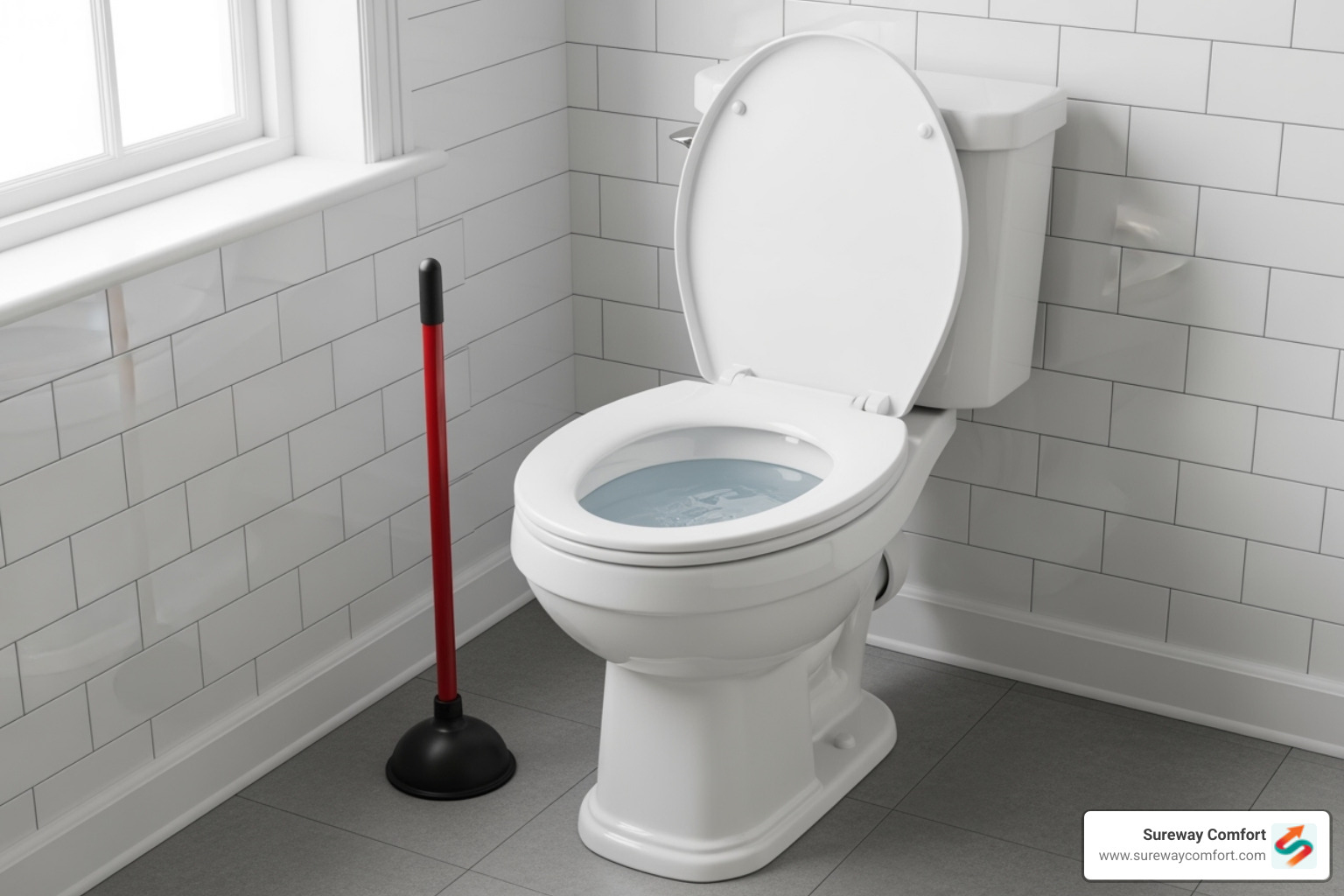


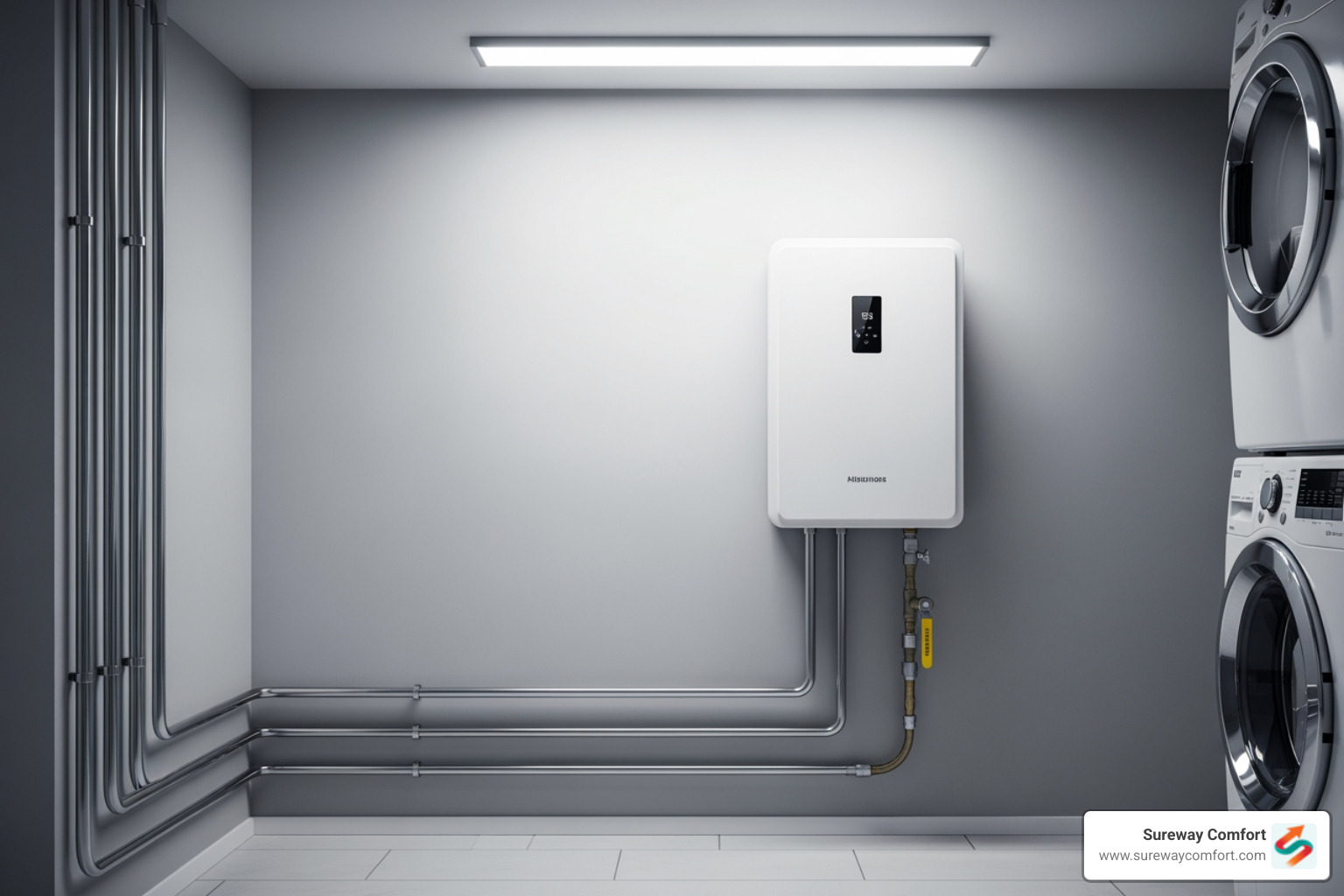
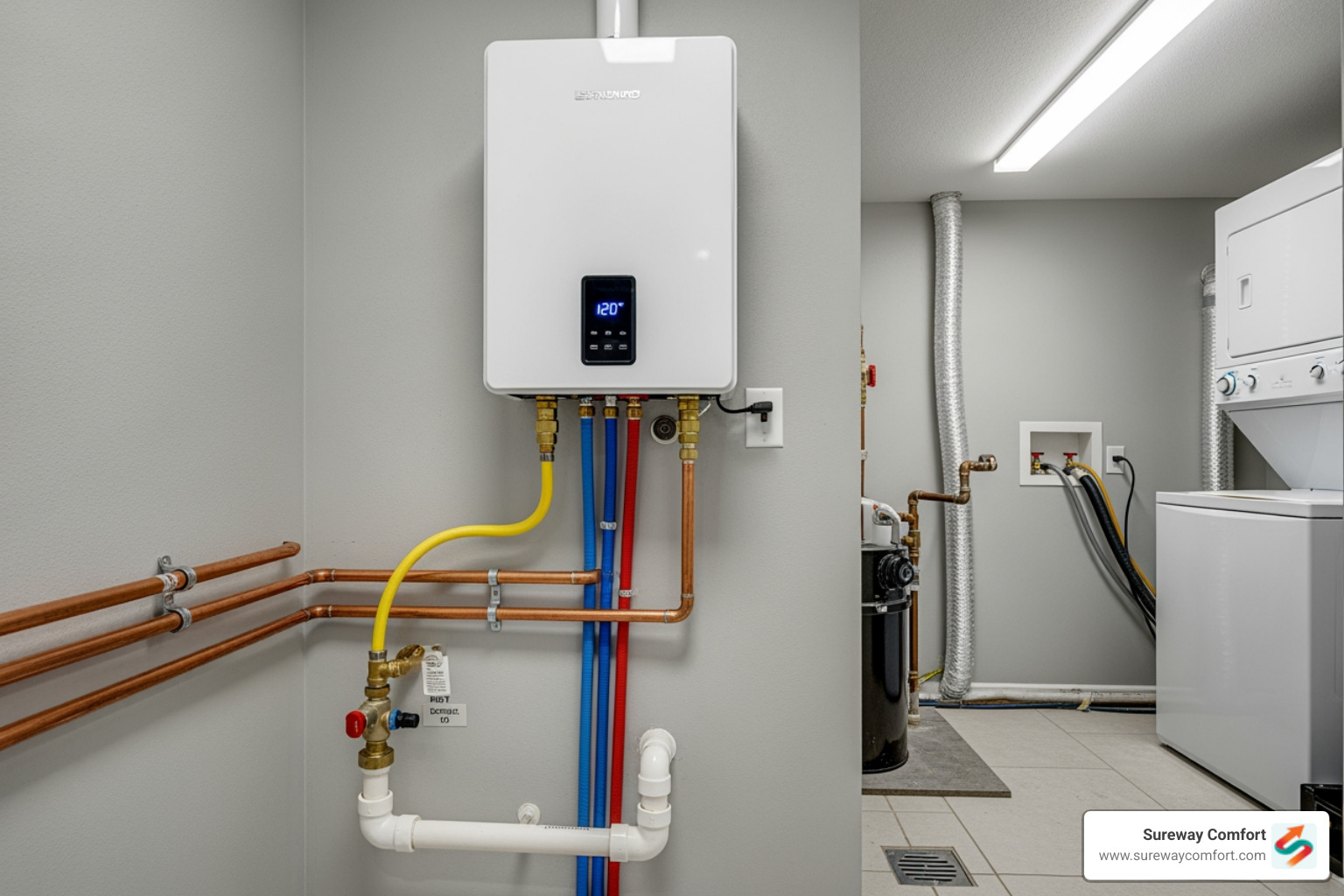




















.avif)



